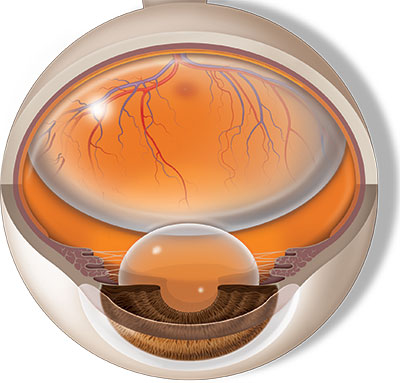What Is a Macular Hole?
Macular hole is when a circular opening forms in your macula. As the hole forms, things in your central vision will look blurry, wavy or distorted. As the hole grows, a dark or blind spot appears in your central vision. A macular hole does not affect your peripheral (side) vision.
What Causes a Macular Hole?
Age is the most common cause of macular hole. As you get older, the vitreous begins to shrink and pull away from the retina. Usually the vitreous pulls away with no problems. But sometimes the vitreous can stick to the retina. This causes the macula to stretch and a hole to form.
Sometimes a macular hole can form when the macula swells from other eye disease. Or it can be caused by an eye injury.
Macular Hole Diagnosis
Your ophthalmologist will put drops in your eye to dilate (widen) your pupil. This allows them to look through a special lens at the inside of your eye.
Then they will take pictures of your eye using optical coherence tomography (OCT). With OCT, a machine scans the back of your eye. This provides very detailed pictures of the retina and macula. Your ophthalmologist studies these pictures to check for problems.
Macular Hole Treatment
Surgery called vitrectomy is the best way to treat a macular hole. Your ophthalmologist removes the vitreous that is pulling on your macula. Then they put a gas bubble inside the eye. This bubble helps flatten the macular hole and hold it in place while your eye heals. The gas bubble slowly goes away on its own.
Things to know about vitrectomy surgery for macular hole:
- Your eye may hurt after surgery. Your surgeon will have you take medicine to help with pain.
- You will need to wear an eye patch for a short time. You also will need to put drops in your eye.

In the face-down position, the bubble is in contact with the macula at the back of the eye.
- You must keep your face down or in a certain position at all times for up to a week, but maybe longer, after vitrectomy surgery. This is to keep the gas bubble in place to heal properly. Talk with your ophthalmologist about when you can do your everyday tasks again.
- You cannot fly in an airplane, go up to mountains or scuba dive until the gas bubble is gone. This is because going up quickly in altitude can make eye pressure rise. That can cause problems with the bubble.
- If you need to have any other type of surgery (including dental work), be sure to tell your doctor before surgery that you have a gas bubble in your eye.
- Your vision will improve as the macular hole closes. It may take several months for the hole to finish healing. How much vision you get back depends on the size of your macular hole. It also depends on how long the hole was there before you had surgery.
What are vitrectomy surgery risks?
Like any surgery, vitrectomy has risks. They include:
Your ophthalmologist will talk about these risks and how vitrectomy surgery may help you.